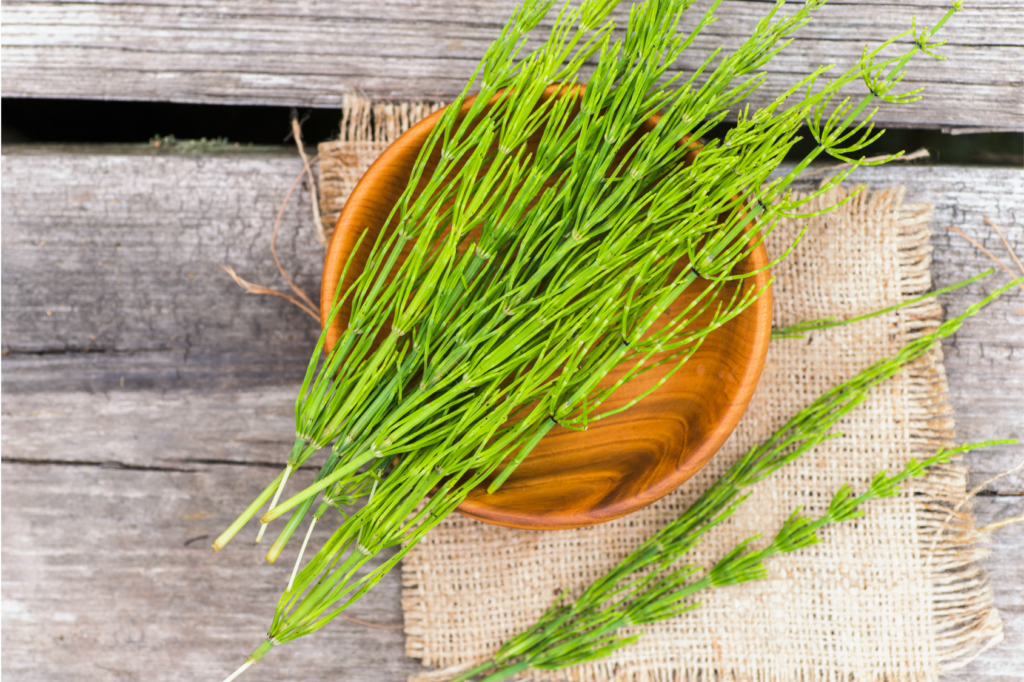By Dr. Leigh Siergiewicz
Equisetum, or horsetail, is the only remaining genus in the prehistoric plant family Equisetaceae. I certainly think it looks like it belonged with dinosaurs, with its crusty texture and poky, bottle brush appearance. It is extremely persistent, with very deep rhizomes that make it extremely difficult to eradicate. It does not flower, and reproduces with spores rather than seeds.
It contains uncommonly high levels of silica because it grows in sand. Silica is an important element for the health of human connective tissue, which includes the bones, cartilage, hair, skin, and nails.
It is particularly well known in traditional medicine for healing the bladder of all kinds of common problems, especially incontinence, as it can help strengthen the tissues. Horsetail is also commonly included in preparations for allergies, osteoporosis, healing broken bones, and weak and brittle hair and nails.
This herb is best prepared as a cold infusion (soaked in cold water for 10 hours or longer) or as a hot tea decocted in a covered pot for 15-20 minutes. Discard the cooked plant and drink. Alcohol preparations should be made with fresh, not dried, herbs.
Some cultures have a history of eating the plant itself, but some sources caution against this as it can cause intestinal irritation. I have not tried this but just looking at it makes me imagine it would hurt my insides. No matter the preparation, using the youngest, most tender tops where the bristly parts are still pointing upward is best.
Science confirming the traditional uses of horsetail is still evolving, however multiple studies referenced from 2010, 2013, and 2014 have found that an aqueous extract of horsetail has anti-inflammatory benefits and supports the immune system.
Horsetail contains an enzyme called thiaminase, which can cause deficiency in thiamin or vitamin B1 if consumed for long periods. If it is prepared as a hot tea, the enzyme is likely denatured, but caution is still warranted. Use for shorter periods or take breaks in between consumption.
As always, be certain about plant identification before consumption. Consult an expert if necessary.
Additional reading:
Cetojević-Simin, D. D., Canadanović-Brunet, J. M., Bogdanović, G. M., Djilas, S. M., Cetković, G. S., Tumbas, V. T., & Stojiljković, B. T. (2010). Antioxidative and antiproliferative activities of different horsetail (Equisetum arvense L.) extracts. Journal of medicinal food, 13(2), 452–459. https://doi.org/10.1089/jmf.2008.0159
Farinon, M., Lora, P. S., Francescato, L. N., Bassani, V. L., Henriques, A. T., Xavier, R. M., & de Oliveira, P. G. (2013). Effect of Aqueous Extract of Giant Horsetail (Equisetum giganteum L.) in Antigen-Induced Arthritis. The open rheumatology journal, 7, 129–133. https://doi.org/10.2174/1874312901307010129
Gründemann, C., Lengen, K., Sauer, B., Garcia-Käufer, M., Zehl, M., & Huber, R. (2014). Equisetum arvense (common horsetail) modulates the function of inflammatory immunocompetent cells. BMC complementary and alternative medicine, 14, 283. https://doi.org/10.1186/1472-6882-14-283
T8ikoilgner, S. (2009). Herbal medicine: From the heart of the Earth. Wise Acres.
Wood, M. (2008). The Earthwise Herbal: A Complete Guide to Old World Medicinal Plants. North Atlantic Books.

